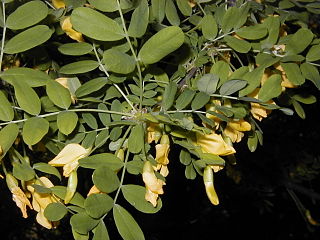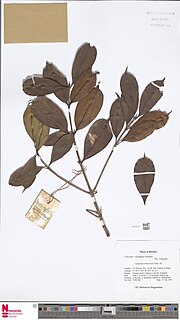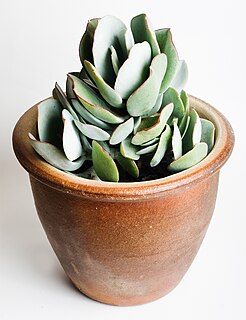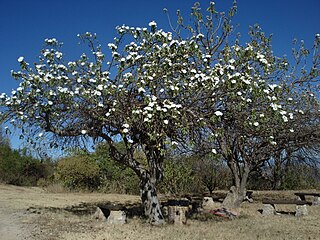
Hydrangea common names hydrangea or hortensia, is a genus of 70–75 species of flowering plants native to Asia and the Americas. By far the greatest species diversity is in eastern Asia, notably Korea, China, and Japan. Most are shrubs 1 to 3 meters tall, but some are small trees, and others lianas reaching up to 30 m (98 ft) by climbing up trees. They can be either deciduous or evergreen, though the widely cultivated temperate species are all deciduous.

Hydrangea arborescens, commonly known as smooth hydrangea, wild hydrangea, sevenbark, or in some cases, sheep flower, is a species of flowering plant in the family Hydrangeaceae. It is a small- to medium-sized, deciduous shrub up to 3 m (10 ft) tall that is native to the eastern United States.

Aloe arborescens, the krantz aloe or candelabra aloe, is a species of flowering succulent perennial plant that belongs to the genus Aloe, which it shares with the well known and studied Aloe vera. The specific epithet arborescens means "tree-like". Aloe arborescens is valued by gardeners for its succulent green leaves, large vibrantly-colored flowers, winter blooming, and attraction for birds, bees, and butterflies.

Caragana arborescens, the Siberian peashrub, Siberian pea-tree, or caragana, is a species of legume native to Siberia and parts of China and neighboring Mongolia and Kazakhstan. It was taken to the United States by Eurasian immigrants, who used it as a food source while travelling west. In some areas of the United States it is considered an invasive species.
Veigaiidae is a family of mites belonging to the superorder Parasitiformes. However they are not parasitic but free-living and predatory and are found in soil and decaying organic matter. Some species are specialists of rocky shorelines. Members of this family can be distinguished by a hyaline appendage on the tarsus of the pedipalp.
Gamasolaelaps bellingeri is a species of mite belonging to the family Veigaiidae. The female is only 0.5 mm in length, the male even smaller. Both can be recognized by the dorsal sclerotized shield being deeply incised laterally. This species is found in damp habitats such as moss and leaf litter in Jamaica.

Cratoxylum arborescens is a plant in the family Hypericaceae. The specific epithet arborescens is from the Latin meaning "tree-like".

Crassula arborescens, the silver jade plant, silver dollar plant, beestebul, Chinese jade, money plant, or money tree, is a species of succulent plant in the family Crassulaceae. It is an endemic plant of the Western Cape, South Africa. It is a 2 to 4 ft succulent shrub. It has round gray "Silver Dollar" leaves. It blooms in winter, with white to pink flowers. It is cultivated as an ornamental plant for use in drought tolerant and succulent gardens, and in container gardens. It is also suitable for growing indoors as a houseplant.

Psorothamnus arborescens is a species of flowering plant in the legume family known by the common name Mojave indigo bush.
Gamasolaelaps multidentatus is a species of mite in the family Veigaiidae.
Gamasolaelaps pygmaeus is a species of mite in the family Veigaiidae.
Gamasolaelaps tuberculatus is a species of mite in the family Veigaiidae.
Gamasolaelaps whartoni is a species of mite in the family Veigaiidae.

Viola arborescens is a species of Viola and is also known as the tree violet. The average height is anywhere from 8 to 10 inches. Viola arborescens requires direct sunlight to grow. Viola arborescens is very cold hardy, and is in bloom all winter and into early spring.

Ipomoea arborescens, the tree morning glory, is a flowering plant coming from the family Convolvulaceae. It grows fast and produces semi succulent stems. This tropical plant is mostly found in Mexico. It flowers in late autumn and winter. Its common name in Nahuatl is Cazahuatl or Cazahuate.

Lomatia arborescens, commonly known as smooth lomatia or tree lomatia, is a shrub or small tree that grows at high altitudes, in and near rainforests. It is found north from the Barrington Tops area in eastern Australia.

Artemisia arborescens, the tree wormwood, is a species of flowering plant in the family Asteraceae, native to the Mediterranean region. It is an erect evergreen perennial, with masses of finely-divided aromatic silvery-white leaves and single-sided sprays of yellow daisy-like flowers. This plant is cultivated for its foliage effects, but in colder temperate regions it requires the protection of a wall.
Dysoxylum arborescens is a tree in the family Meliaceae. The specific epithet arborescens is from the Latin meaning "tree-like".

Hakea arborescens, commonly known as the common hakea or the yellow hakea, is a shrub or tree of the genus Hakea native to parts of northern Australia.
Arfeuillea is a monotypic genus in the family Sapindaceae with Arfeuillea arborescens as its only species. Commonly known as hop tree, this species is characterized by compound leaves arranged spirally around the branches, flowers with small white petals and larger red sepals, and dehiscent papery yellow fruits with two black seeds encased. It is native to Laos and Thailand but is cultivated only and not found in the wild. The species serves as a street tree across its native range and in Malaysia and Singapore, and its antioxidant-rich leaves are included in many Thai herbal medicines.











